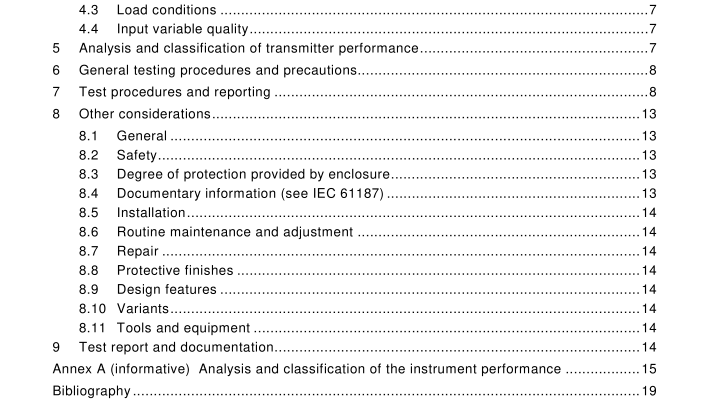IEC 60770-1:2010 pdf download – Transmitters for use in industrial-process control systems – Part 1: Methods for performance evaluation
3 Terms and definitions For the purposes of this part of IEC 60770, definitions given in IEC 60050-300 and in IEC 61 298-1 are applicable. 4 General conditions for tests
4.1 Overview For the purpose of this standard, the general test conditions (e.g. environmental test conditions, supply conditions, load conditions, mounting position, externally induced vibrations, external mechanical constraints, constancy of the operating conditions and settings, input variable quality, delivery of the transmitter, etc.) specified in IEC 61 298-1 apply, together with the additional information below. NOTE It is desirable that the closest communication should be maintained between the manufacturer and the evaluating body. The manufacturer’s specifications for the instrument should be taken into account when the test programme is being decided, and the manufacturer should be invited to comment on both the test programmes and the results.
4.2 Supply conditions For the two-wire transmitters, the normal supply voltage might be 24 V d.c. For pneumatic transmitters, the normal pressure supply might be 1 40 kPa (1 ,4 bar). Tolerances on supply conditions, as given in IEC 61 298-1 , are not applicable to transmitters with self-contained power supplies (e.g. battery-powered). The tolerance for battery-powered equipment shall be agreed.
4.3 Load conditions The value of the load to be used shall be agreed. A load of 250 Ω is a commonly used value for electrical transmitters. For pneumatic transmitters, unless otherwise specified, a test load consisting of an 8 m long rigid pipe with a 4 mm internal diameter, followed by a 20 cm 3 capacity (or more), shall be used. Care should be taken to ensure that pneumatic connections are leak-tight.
4.4 Input variable quality For transmitters that are to be evaluated with an integral sensor, the conditions and requirements for maintaining the quantities to be measured (physical/chemical) shall be properly stated (e.g. for flow transmitters, the fluid through the measuring device shall be that specified by the manufacturer; the temperature of the fluid shall be maintained within ±2 °C of the value specified in order to ensure the correct values of density and viscosity).
5 Analysis and classification of transmitter performance In determining the test programme and test values to be used in the evaluation, the physical and functional design of transmitter should be taken into account. Guidance on this process can be found in Annex A.
6 General testing procedures and precautions For the purpose of this standard, the general testing procedures and precautions (e.g. identification and inspection, preparation for the tests, uncertainty of the measuring system, traceability, tapping, setting of adjustments, preconditioning, sequence of tests, interruption and duration of each series of measurements, anomalies and failures during tests, re-start of a test, input/output variable relationships, error assessment, symbols and units of measurement, etc.) specified in IEC 61 298-1 shall be applied. The instrument shall be calibrated by the manufacturer and tested without recalibration. Then additional measurements should be made at the lowest and highest possible span and the remainder of the tests should be carried out at the mean value.
7 Test procedures and reporting
The tests given in Tables 1 , 2 and 3 are suitable for industrial process transmitters. If a full evaluation is planned, each applicable test should be conducted. The results should be reported as a percentage of the output span. Unexpected events, including faults and malfunctions, shall be reported. The test procedures and precautions are described in detail in IEC 61 298-2 and IEC 61 298-3.
8 Other considerations
8.1 General
Additional tests may be carried out in order to verify some other characteristics of the transmitter, such as the safety and degree of protection provided by the enclosure.
In order to prepare the general information required for the test report, procedures for
• installation,
• routine maintenance and adjustment,
• repairs and overhaul,
